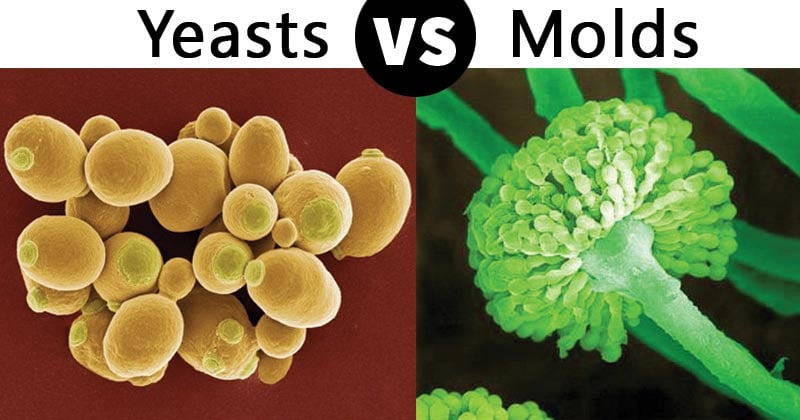Interesting Science Videos
Differences between Yeasts and Molds
Both yeast and molds are eukaryotes – organisms with cell nuclei and membrane-bound organelles in the kingdom Fungi.

The major differences between Yeasts and Molds are:
S.N. |
Character |
Yeasts |
Molds |
| 1. | Definition | Yeast is a unicellular, budding fungus. | Mold is a multicellular, threadlike fungus. |
| 2. | Form | Grow as large single cells. | Grow as multiple tubular branches. |
| 3. | Cell type | Unicellular | Multicellular |
| 4. | Habitat | Very common. It can be found on fruit and berries, in the stomachs of mammals and on the skin, among other places. | Typically found in damp, dark or humid areas. |
| 5. | Appearance | White and thready. Usually oval in shape. | Mold has a fuzzy appearance and can be found in several shapes. |
| 6. | Hyphae | Yeasts do not have true hyphae. Instead, they form multicellular structures called pseudo-hyphae. | Molds have microscopic filaments called hyphae. |
| 7. | Spore | Yeast is a not a sporing species of fungi. | Mold is a sporing fungus |
| 8. | Colony morphology | Yeast colonies are soft, opaque and cream-colored. | Filamentous type colony with vegetative hyphae and aerial hyphae. |
| 9. | Color | Yeasts are less colorful compared to molds (colorless). | Molds are very colorful and maybe orange, green, black, brown, pink or purple. |
| 10. | Incubation Temperature | Routine incubation temperature is usually 25oC to 30oC (room temperature). | Routine incubation temperature is usually 25o to 30o C, although 35o C incubation can be used to differentiate some molds based on temperature tolerance or to determine whether organisms are diphasic. |
| 11. | Cultivation time | These organisms usually grow within 24 to 36 hours after inoculation on media. | These organisms usually grow more slowly than yeasts after inoculation to media. |
| 12. | Aerobic/Anaerobic | Yeast can grow in aerobic as well as in anaerobic conditions. | Molds grow only in aerobic conditions. |
| 13. | pH range for growth | Growth limited to a pH range of 4.0 to 4.5. | Mold can grow in a wider range of acidity (pH) levels than yeasts. |
| 14. | Diagnosis/
Identification |
Identification bases on physiologic tests and a few key morphologic differences. | Most clinical molds can be determined by microscopic examination of the ontogeny and morphology of their asexual spores. |
| 15. | Reproduction | Most reproduce asexually through mitosis. The most common form called “budding.” A smaller number of yeasts reproduce by binary fission. | Reproduce through small spores, which can be either sexual or asexual. |
| 16. | Asexual Spores | Blastospore | Sporangiospores and Conidia |
| 17. | Sexual Spores | No Sexual Spores. | Zygospores, Ascospores, and Basidiospores |
| 18. | Energy Production | Convert carbohydrates to alcohol and carbon dioxide in anaerobic through fermentation. Also, obtain carbon from hexose sugars. | Secrete hydrolytic enzymes that degrade biopolymers such as starch, cellulose, and lignin into simpler substances that can be absorbed. |
| 19. | Health risks | It can cause infection in individuals with compromised immune systems. | It can cause allergic reactions and respiratory problems. |
| 20. | Other risks | Comparatively less involved in spoilage. | Molds cause a greater threat in terms of food spoilage and sanitation concerns, particularly in fresh produce. |
| 21. | Uses | Ethanol production, baking, vitamin supplements, the study of the cell cycle. | Some molds are used in food production, for example, Penicillium is used in the production of cheese, Neurospora in the production of oncom, which is made from the by-product of tofu. Mold is also a crucial saprophyte. |
| 22. | Species | 1500 known species – 1% of all fungi. | There are 400,000 types of molds. |
| 23. | Examples | Saccharomyces cerevisiae, Cryptococcus neoformans, etc. | Alternaria, Aspergillus, Fusarium, Mucor, Penicillium, Rhizopus, Trichophyton, etc. |
References
- https://www.diffen.com/difference/Mold_vs_Yeast
- https://microbiologyinfo.com/difference-between-mold-and-yeast/
- https://sciencing.com/differences-between-yeasts-moulds-8168625.html
- Parija S.C. (2012). Textbook of Microbiology & Immunology.(2 ed.). India: Elsevier India.
- Sastry A.S. & Bhat S.K. (2016). Essentials of Medical Microbiology. New Delhi : Jaypee Brothers Medical Publishers.

Thank good notes
Thanks for sharing. I never thought molds and yeasts are so different.
Regards,
Kurt
wow breif and clear note. keep it up
Excellent